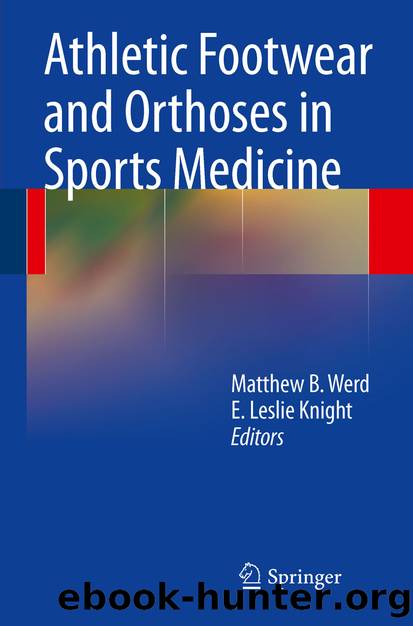Athletic Footwear and Orthoses in Sports Medicine by Matthew B. Werd & E. Leslie Knight

Author:Matthew B. Werd & E. Leslie Knight
Language: eng
Format: epub
Publisher: Springer New York, New York, NY
Classifying Running Shoes
Numerous guidelines for the categorization of running shoes have been circulated in the popular press. The following list of general categories is the most widely accepted and used for running shoes:Cushioning
Neutral
Stability
Motion control
Racing
Considerable overlap may exist; shoe authorities and manufactures may disagree on the assignment of a shoe to a category. However, based upon long-standing use and acceptance by the public this system provides a good starting point for the selection of an optimal training and racing shoe for the triathlete.
Shoes for cushioning represent designs which emphasize cushioning and flexibility. These shoes typically possess a uniform density midsole, limited shoe stabilizing add-in features, and an outsole which promotes flexibility while maintaining good traction with the support surface. These shoes promote an efficient running gait and rely on normal lower extremity and foot biomechanics. These shoes are best suited for the efficient lightweight runner with a normal to high-arched foot who demonstrates normal lower extremity biomechanics. The neutral shoe represents a design which promotes adequate cushioning, flexibility with the addition of limited stabilizing features. These shoes are best worn by a lightweight runner who exhibits normal lower extremity biomechanics. Stability running shoes are designed with the intent to augment the natural stability of the foot through all phases of gait. These shoes emphasize adequate cushioning and forefoot flexibility and enhanced motion controlling properties. These shoes are best worn by lightweight through normal weight runners with normal through moderately abnormal lower extremity biomechanics. Runners with normal foot biomechanics may elect to use this shoe to promote greater stability, especially during runs when fatigue influences normal running gait. Motion control shoes are intended to promote a maximum level of support and influence under the most extreme levels of excessive pronation of the foot during all phases of the running gait cycle. These shoes are better suited for runners with low-arched or a pes planus foot type and work well for individuals competing in the heavy weight class. These shoes are generally poorly suited for the lightweight runner due to the presence of very firm midsole materials which can promote excessive resistance to the normal foot function. Racing shoes represent a very special classification of running shoe; these shoes are intended to be lightweight and generally are poorly suited for the average triathlete.
Design innovations are frequently introduced to existing shoe models or shoe line-ups; however, rarely are entirely new design concepts introduced. However, Nike with introduction of the Nike Free brought to the running community an entirely new shoe classification. These shoes are designed as training or racing flats which intend to simulate the act of running barefoot while still proving adequate protection from foreign objects. These shoes do offer the triathlete with a training shoe to augment the strengthening of intrinsic musculature, otherwise not strengthened in a traditional shoe. However, these shoes provide little in the way of support for a foot which exhibits excessive pronation or for the runner which exhibits pronation of the foot through the midstance and propulsive phases of gait.
Download
This site does not store any files on its server. We only index and link to content provided by other sites. Please contact the content providers to delete copyright contents if any and email us, we'll remove relevant links or contents immediately.
When Breath Becomes Air by Paul Kalanithi(7278)
Why We Sleep: Unlocking the Power of Sleep and Dreams by Matthew Walker(5666)
Paper Towns by Green John(4179)
The Immortal Life of Henrietta Lacks by Rebecca Skloot(3834)
The Sports Rules Book by Human Kinetics(3600)
Dynamic Alignment Through Imagery by Eric Franklin(3504)
ACSM's Complete Guide to Fitness & Health by ACSM(3475)
Kaplan MCAT Organic Chemistry Review: Created for MCAT 2015 (Kaplan Test Prep) by Kaplan(3431)
Introduction to Kinesiology by Shirl J. Hoffman(3308)
Livewired by David Eagleman(3139)
The River of Consciousness by Oliver Sacks(3000)
Alchemy and Alchemists by C. J. S. Thompson(2918)
The Death of the Heart by Elizabeth Bowen(2911)
Descartes' Error by Antonio Damasio(2747)
Bad Pharma by Ben Goldacre(2738)
The Gene: An Intimate History by Siddhartha Mukherjee(2502)
Kaplan MCAT Behavioral Sciences Review: Created for MCAT 2015 (Kaplan Test Prep) by Kaplan(2495)
The Fate of Rome: Climate, Disease, and the End of an Empire (The Princeton History of the Ancient World) by Kyle Harper(2444)
The Emperor of All Maladies: A Biography of Cancer by Siddhartha Mukherjee(2440)
